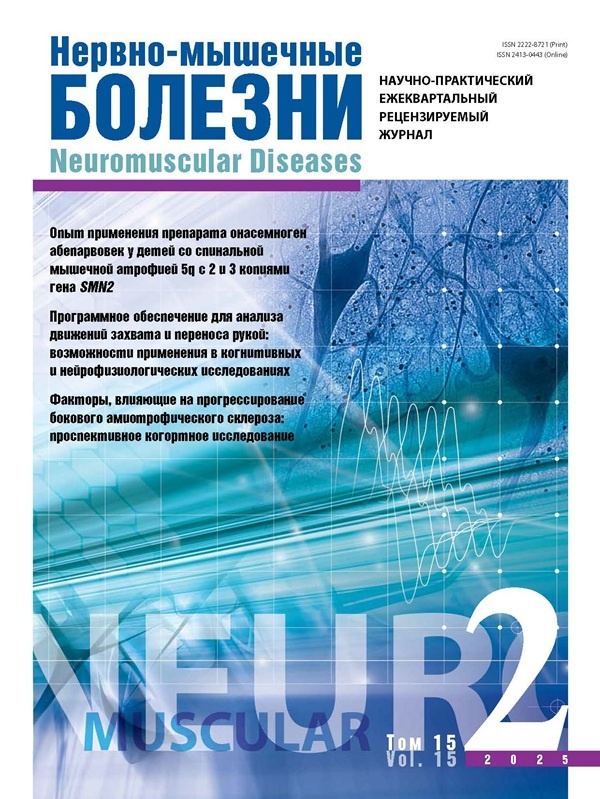Software for the analysis of reach-to-grasp and transport movements: applications in cognitive and neurophysiological research
- Authors: Vyazmin A.O.1, Chapanova M.R.2, Morozov M.S.2, Aksenov S.A.2, Feurra M.1
-
Affiliations:
- Centre for Cognition and Decision making, Institute for Cognitive Neuroscience, National Research University “Higher School of Economics”
- School of Applied Mathematics, Tikhonov Moscow Institute of Electronics and Mathematics, National Research University “Higher School of Economics”
- Issue: Vol 15, No 2 (2025)
- Pages: 28-36
- Section: ORIGINAL REPORTS
- Published: 23.09.2025
- URL: https://nmb.abvpress.ru/jour/article/view/656
- DOI: https://doi.org/10.17650/2222-8721-2025-15-2-28-36
- ID: 656
Cite item
Full Text
Abstract
Aim. To present Kinematic 4, a software tool designed for automated analysis of reach-to-grasp and object transport movements using data obtained from motion capture systems.
Materials and methods. The software was developed in Python and implements algorithms for automatic detection of key temporal events in motor actions. Initially validated in MATLAB, the algorithmic framework was adapted into a cross-platform desktop application with a graphical user interface. Kinematic 4 processes coordinate data from markers placed on the thumb, index finger, wrist, object, and specialized glasses with a movable shutter. The program identifies six critical time points: experiment onset, hand lifting, finger opening, maximum grasp aperture, object lifting, and object placement.
Results. Comparison between results obtained using Kinematic 4 and those generated by the original MATLAB script demonstrated full consistency. The software was successfully validated on experimental datasets and showed high stability. Its user-friendly interface and automated workflow make it a reliable and reproducible tool for both research and clinical applications.
Conclusion. Kinematic 4 can be effectively used for assessing upper-limb movements in neuroscience and clinical contexts, including the diagnosis of motor impairments and monitoring of recovery dynamics. Future development may include integration with other biosignals and machine learning modules for predictive analytics.
About the authors
A. O. Vyazmin
Centre for Cognition and Decision making, Institute for Cognitive Neuroscience, National Research University “Higher School of Economics”
Author for correspondence.
Email: aovyazmin@hse.ru
ORCID iD: 0000-0003-2346-4222
Aleksandr Olegovich Vyazmin,
20, Myasnitskaya St., Moscow 101000.
Russian FederationM. R. Chapanova
School of Applied Mathematics, Tikhonov Moscow Institute of Electronics and Mathematics, National Research University “Higher School of Economics”
Email: fake@neicon.ru
ORCID iD: 0009-0003-4328-5325
34, Tallinskaya St., Moscow 123458.
Russian FederationM. S. Morozov
School of Applied Mathematics, Tikhonov Moscow Institute of Electronics and Mathematics, National Research University “Higher School of Economics”
Email: fake@neicon.ru
ORCID iD: 0009-0003-9388-2849
34, Tallinskaya St., Moscow 123458.
Russian FederationS. A. Aksenov
School of Applied Mathematics, Tikhonov Moscow Institute of Electronics and Mathematics, National Research University “Higher School of Economics”
Email: fake@neicon.ru
ORCID iD: 0000-0003-4403-7246
34, Tallinskaya St., Moscow 123458.
Russian FederationM. Feurra
Centre for Cognition and Decision making, Institute for Cognitive Neuroscience, National Research University “Higher School of Economics”
Email: fake@neicon.ru
ORCID iD: 0000-0003-0934-6764
20, Myasnitskaya St., Moscow 101000.
Russian FederationReferences
- MacKenzie C. L., Iberall T. The Grasping Hand. Amsterdam: Elsevier, 1994. 256 p.
- Jeannerod M. The timing of natural prehension movements. J Motor Behav 1984;16(3):235–54. doi: 10.1080/00222895.1984.10735307
- Castiello U. The neuroscience of grasping. Nat Rev Neurosci 2005;6(9):726–36. doi: 10.1038/nrn1744
- Nowak D. A. The impact of stroke on the performance of grasping: Usefulness of kinetic and kinematic motion analysis. Neurosci Biobehav Rev 2008;32(8):1439–50. doi: 10.1016/j.neubiorev.2008.04.017
- Fasano A., Mazzoni A. Reaching and grasping movements in Parkinson’s disease: A review. J Parkinsons Dis 2022;12(4): 1083–113. doi: 10.3233/JPD-223102
- Wiesendanger M., Serrien D. J. Neurological problems affecting hand dexterity. Brain Res Rev 2001;36(2–3):161–8. doi: 10.1016/S0165-0173(01)00085-6
- Betti S., Zani G., Guerra S. et al. Reach-to-grasp movements: A multimodal techniques study. Front Psychol 2018;9:990. doi: 10.3389/fpsyg.2018.00990
- Sartori L., Spoto A., Gatti M., Straulino E. The shape of water: How tai chi and mental imagery effect the kinematics of a reach-to-grasp movement. Front Physiol 2020;11:297. doi: 10.3389/fphys.2020.00297
- Frykberg G. E., Grip H., Alt Murphy M. How many trials are needed in kinematic analysis of reach-to-grasp? A study of the drinking task in persons with stroke and non-disabled controls. J Neuroeng Rehabil 2021;18(1):13. doi: 10.1186/s12984-021-00806-w
- Paulignan Y., Frak V. G., Toni I., Jeannerod M. Influence of object position and size on human prehension movements. Exp Brain Res 1997;114(2):226–34. doi: 10.1007/PL00005653
- Sziburis T., Blex S., Glasmachers T., Iossifidis I. Ruhr hand motion catalog of human center-out transport trajectories in 3D task-space captured by a redundant measurement system. arXiv e-prints; arXiv:2401.00562. doi: 10.48550/arXiv.2401.00562
- Mazzarella J., Richie D., Chaudhari A. M. W. et al. Object weight and hand dominance impact kinematics in a functional reach-to-drink task in school-aged children. Sensors (Basel) 2024;24(16):5421. doi: 10.3390/s24165421
- Choi H., Park D., Rha D. W. et al. Kinematic analysis of movement patterns during a reach-and-grasp task in stroke patients. Front Neurol 2023;14:1225425. doi: 10.3389/fneur.2023.1225425
- Murphy M. A., Willén C., Sunnerhagen K. S. Kinematic variables quantifying upper-extremity performance after stroke during reaching and drinking from a glass. Neurorehabil Neural Repair 2011;25(1):71–80. doi: 10.1177/1545968310370743
- Vyazmin A. O., Ragimova A. A., Si G. L. et al. Efficiency of object movement depending on its orientation in space: kinematic analysis of motor planning and execution. Nervno-myshechnye bolezni = Neuromuscular Diseases 2024;14(3):38–53. (In Russ.). DOI: https://doi.org/10.17650/2222-8721-2024-14-3-38-53
- Wong A. L., Haith A. M., Krakauer J. W. Motor planning. Neurosci 2015;21(4):385–98. doi: 10.1177/1073858414557845
- Johansson R. S., Flanagan J. R. Coding and use of tactile signals from the fingertips in object manipulation tasks. Nat Rev Neurosci 2009;10(5):345–59. doi: 10.1038/nrn2621
- Scott S. H. Optimal feedback control and the neural basis of volitional motor control. Nat Rev Neurosci 2004;5(7):532–45. doi: 10.1038/nrn1427
- Zhang J., Xiao Yu., Li Z.-M. et al. Reach-to-grasp kinematics and kinetics with and without visual feedback in early-stage Alzheimer’s disease. J Neuroeng Rehabil 2022;19(1):121. doi: 10.1186/s12984-022-01060-5
- Pardhan S., Scarfe A., Bourne R., Timmis M. A comparison of reach-to-grasp and transport-to-place performance in participants with age-related macular degeneration and glaucoma. Invest Ophthalmol Vis Sci 2017;58(3):1560–9. doi: 10.1167/iovs.16-21008
- Shadmehr R., Krakauer J. W. A computational neuroanatomy for motor control. Exp Brain Res 2008;185(3):359–81. doi: 10.1007/s00221-007-1269-0
Supplementary files







